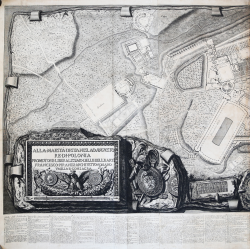






| Reference: | S40511 |
| Author | Giovan Battista PIRANESI |
| Year: | 1781 |
| Zone: | Villa Adriana |
| Measures: | 3100 x 820 mm |





| Reference: | S40511 |
| Author | Giovan Battista PIRANESI |
| Year: | 1781 |
| Zone: | Villa Adriana |
| Measures: | 3100 x 820 mm |
Etching and engraving, 1781, signed on the lower plate by Francesco Piranesi, who completed the composition after the death of his father Giovan Battista in 1778.
At the bottom, inside the image, we find Piranesi's dedication to the King of Poland: ALLA MAESTÀ DI STANISLAO AVGVSTO RE DI POLONIA PROMOTORE LIBERALISSIMO DELLE BELLE ARTI FRANCESCO PIRANESI ARCHITETTO ROMANO VMILIA E CONSAGRA.
Magnificent proof of the very rare first edition, printed on six large sheets of contemporary laid paper and pasted to 19th century cloth, light browning, some paper creases, overall, in very good condition.
Giovan Battista Piranesi dedicated to the study and to the relief of Villa Adriana most of his life, beginning to explore the famous Hadrian's villa less than a year after his arrival in Rome. It is derived from the signature in blood and its date (1741) that Giovan Battista left the vault of the staircase leading to the portico. Piranesi returned to the villa several other times over the years and in 1763, in a wall of the west, he left again signing with the comment about the "desperate and 'almost impossible task" which occupied him more than any other in recent years. At the end of Piranesi, with the help of the architect Charles-Louis Clérisseau, Robert Adam and Claude Joseph Vernet, was among the first to "draw and draw Villa Adriana" "making their way 'with an ax through the brambles for lighting fires 'chase away snakes and scorpions.' "It took 250 drawings of plans and elevations of father and son Francesco Piranesi. The final design, preparation for the engraving, is 64 cm high and over three meters long, provides the floor plan of the entire complex. The plan to release, which was completed by his son Franceco in 1781, consists of six panels each 81 cm high and 51 long, for a total of over three meters.
The text accompanying the work which extends in the lower part, includes 434 numbers and is based on information derived from previous studies of Pirro Ligorio and Contini.
Although some catalogues list it among the works of Francesco Piranesi, most scholars undoubtedly assign the work to his father.
Magnificent example in the rare early edition.
Bibliografia
J. Wilton-Ely, Giovan Battista Piranesi, The complete etchings (1994): n. 1009; Le Blanc C., Manuel de l'amateur d'Estampes, 6, V. 2 p. 207, 1854-59; C.A. Petrucci, Catalogo Generale Delle Stampe Tratte Dai Rami Incisi Posseduti Dalla Calcografia Nazionale, 1026, p. 301, tav. 15, 1953.
Giovan Battista PIRANESI (Mogliano Veneto 1720 - Roma 1778)
|
Italian etcher, engraver, designer, architect, archaeologist and theorist. He is considered one of the supreme exponents of topographical engraving, but his lifelong preoccupation with architecture was fundamental to his art. Although few of his architectural designs were executed, he had a seminal influence on European Neo-classicism through personal contacts with architects, patrons and visiting artists in Rome over the course of nearly four decades. His prolific output of etched plates, which combined remarkable flights of imagination with a strongly practical understanding of ancient Roman technology, fostered a new and lasting perception of antiquity. He was also a designer of festival structures and stage sets, interior decoration and furniture, as well as a restorer of antiquities. The interaction of this rare combination of activities led him to highly original concepts of design, which were advocated in a body of influential theoretical writings. The ultimate legacy of his unique vision of Roman civilization was an imaginative interpretation and re-creation of the past, which inspired writers and poets as much as artists and designers.
|
Giovan Battista PIRANESI (Mogliano Veneto 1720 - Roma 1778)
|
Italian etcher, engraver, designer, architect, archaeologist and theorist. He is considered one of the supreme exponents of topographical engraving, but his lifelong preoccupation with architecture was fundamental to his art. Although few of his architectural designs were executed, he had a seminal influence on European Neo-classicism through personal contacts with architects, patrons and visiting artists in Rome over the course of nearly four decades. His prolific output of etched plates, which combined remarkable flights of imagination with a strongly practical understanding of ancient Roman technology, fostered a new and lasting perception of antiquity. He was also a designer of festival structures and stage sets, interior decoration and furniture, as well as a restorer of antiquities. The interaction of this rare combination of activities led him to highly original concepts of design, which were advocated in a body of influential theoretical writings. The ultimate legacy of his unique vision of Roman civilization was an imaginative interpretation and re-creation of the past, which inspired writers and poets as much as artists and designers.
|